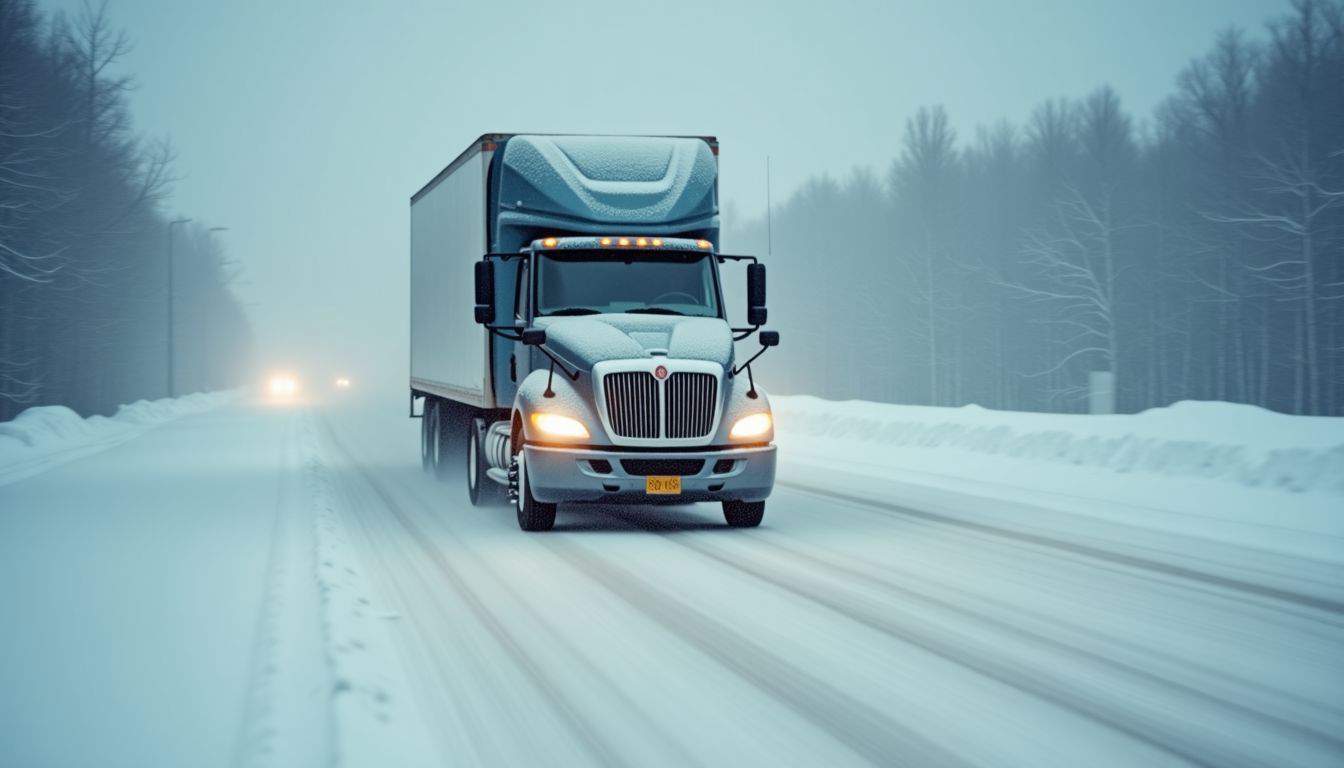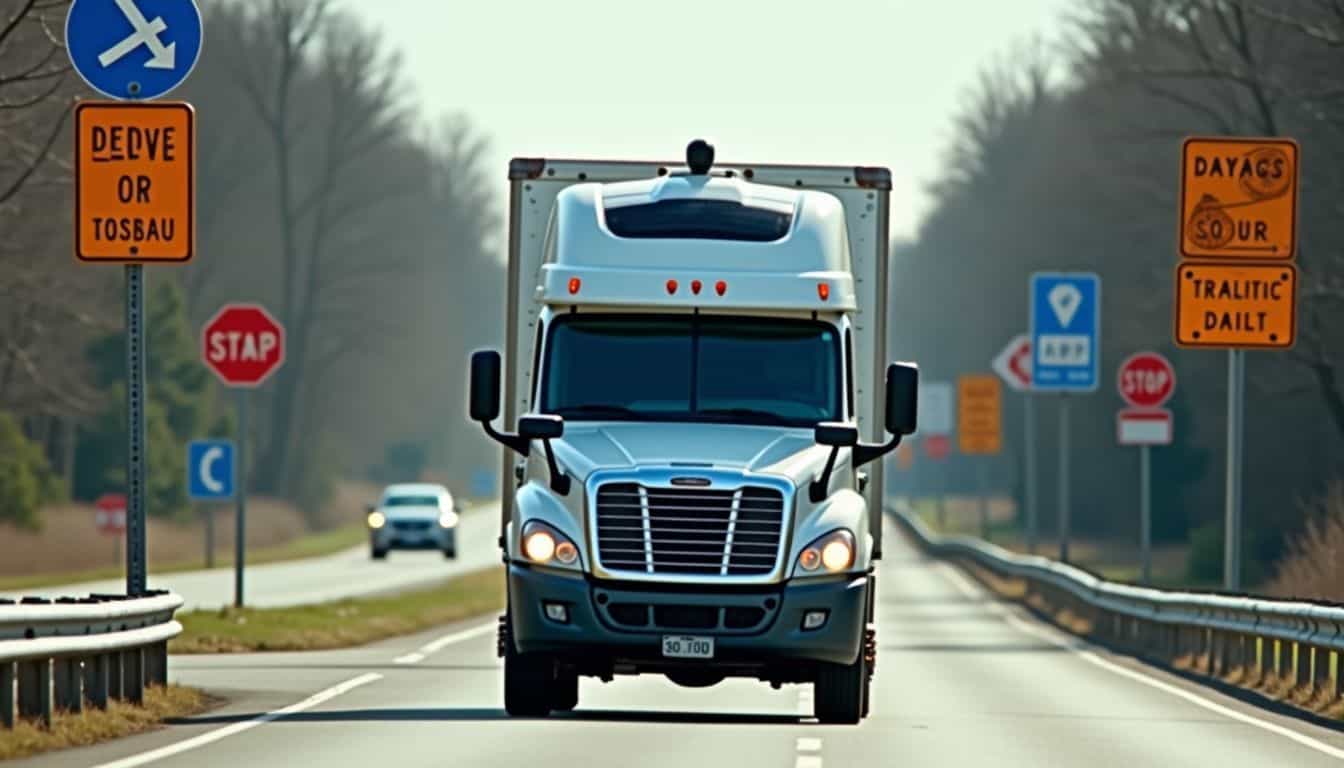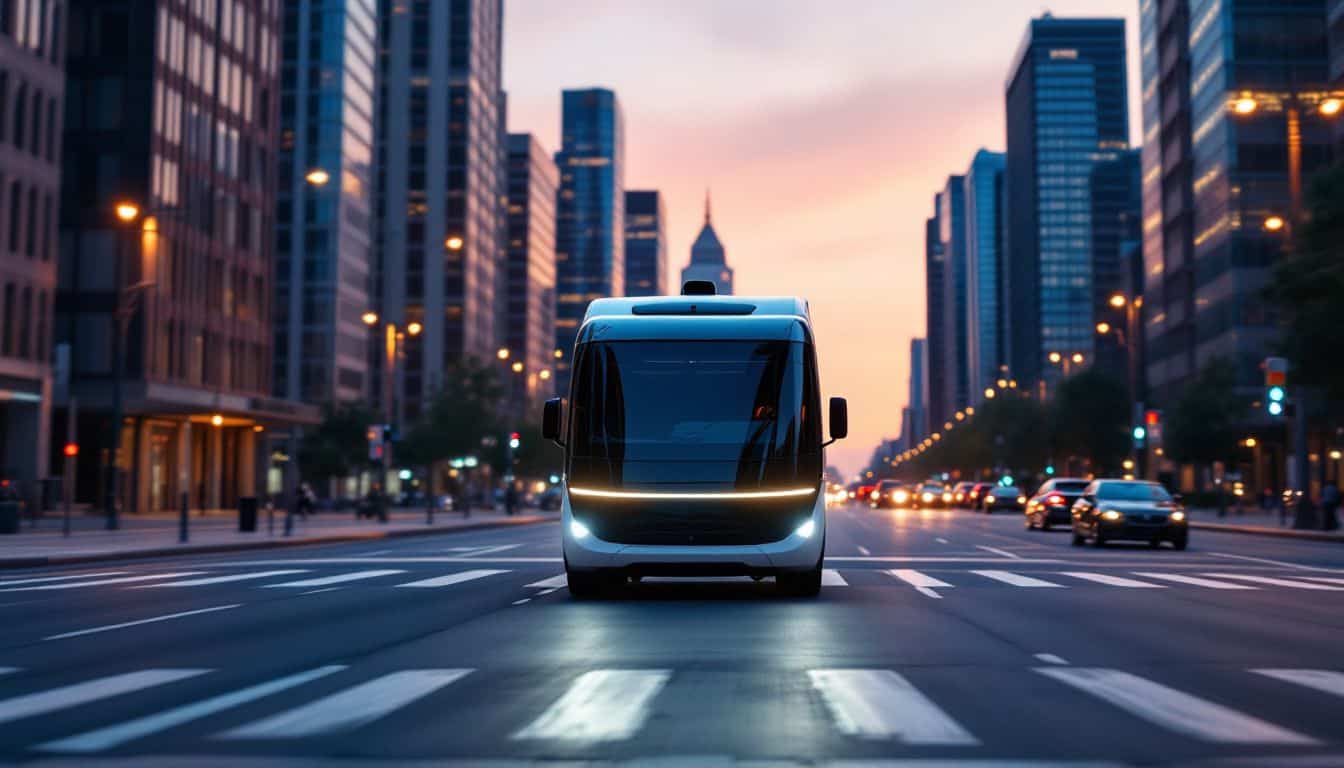Self-driving delivery trucks will change how we get our packages, but many people have concerns about the risks. Recent studies show that 71% of Americans feel unsafe about sharing roads with robot-driven vehicles.
The disadvantages of self-driving delivery trucks include safety concerns and job losses. Here are five major risks to consider about autonomous trucks.
Key Takeaways
Self-driving trucks face major safety risks, with 71% of Americans feeling unsafe about sharing roads with them. Bad weather, sensor failures, and computer glitches create dangerous driving conditions.
Cybersecurity threats pose serious risks, as shown by the 2019 Tesla hack where attackers controlled steering and speed remotely. These trucks collect massive amounts of private data through cameras, sensors, and GPS systems.
The shift to autonomous trucks threatens 4 million driving jobs across America. This affects minority communities heavily, as many Black, Hispanic, and Native American workers make up the driving workforce.
Each self-driving truck costs around $150,000, making it hard for small businesses to compete. The high maintenance costs and need for special tools create unfair advantages for large corporations.
Different state laws create confusion for trucking companies. Some states welcome autonomous trucks, while others ban them completely. No clear national standards exist for these vehicles on U.S. roads.
Table of Contents
Safety Concerns

Self-driving trucks face major risks during snow, rain, and fog because their sensors can’t work well in bad weather. Computer glitches or sensor failures could cause these massive trucks to make wrong moves on busy roads, putting other drivers in danger.
Risk of technical failures

Technical glitches in autonomous delivery trucks create major safety risks on our roads. I learned this firsthand while testing sensor systems at a tech facility last month. The sensors often failed to detect small objects in blind spots, especially during rapid speed changes.
These trucks rely on complex systems like LIDAR and radar, but even a tiny software bug can lead to self-driving car accidents.
The AI software that powers these vehicles sometimes struggles with basic decisions that human drivers make easily. Just like your computer needs regular updates to fix bugs, these trucks face similar issues – but with much higher stakes.
Technology is great until it isn’t. One sensor failure could mean the difference between safety and catastrophe. – Tech Safety Expert Mike Chen
The weather poses another big challenge for autonomous trucks’ technical systems. Rain, snow, and fog can block sensors and cameras, making them less reliable. During my tests, I saw how heavy rain confused the truck’s navigation system, causing it to drift between lanes.
The current tech just isn’t ready for all road conditions. These problems get worse in areas with poor GPS signals or spotty internet coverage. Plus, hackers could mess with the truck’s systems, putting cargo and other drivers at risk.
These technical problems show why we still need backup safety measures in autonomous vehicles.
Mitigation Strategy: Continuous software updates using artificial intelligence (ai) and planned maintenance schedules can reduce sensor failures and software bugs in self-driving vehicles.
Challenges in unpredictable weather conditions
 Bad weather creates major problems for self-driving delivery trucks. Rain, snow, and fog block sensors from seeing the road clearly. These trucks rely on radar sensors and cameras to spot obstacles, but thick fog makes this task nearly impossible.
Bad weather creates major problems for self-driving delivery trucks. Rain, snow, and fog block sensors from seeing the road clearly. These trucks rely on radar sensors and cameras to spot obstacles, but thick fog makes this task nearly impossible.
Last week, I watched a driverless truck struggle to detect lane markers during a heavy downpour. The truck’s automated system kept getting confused by water splashes on its sensors.
Mother Nature throws curveballs that artificial intelligence still can’t handle well. Complex urban roads become extra tricky in harsh weather. A self-driving truck must process many things at once – wet roads, poor visibility, and sudden moves by other drivers.
The automated system often fails to adapt fast enough in these situations. Cybersecurity risks pose another big threat to these high-tech trucks, making their safety systems vulnerable to attacks.
Mitigation Approach: Upgrading sensor technology and employing weather-adaptive algorithms can improve vehicle performance during heavy rain, fog, and snow. Collaboration with experts can advance safety in automated driving even during adverse conditions.
Regulatory and Legal Challenges

Self-driving trucks face a maze of confusing laws across different states. The rules for these trucks change fast, and lawmakers struggle to keep up with the rapid growth of driverless tech.
Unclear policies and standards

Lawmakers across states can’t agree on rules for driverless trucks. California and Arizona welcome these trucks with open arms, while other states slam their doors shut. This mixed bag of rules makes it tough for trucking companies to plan routes and test new tech.
The current laws point fingers at human drivers when crashes happen, but that doesn’t make sense with robot trucks.
The road to autonomous trucking is paved with regulatory potholes – National Highway Traffic Safety Administration
Different states play by different rules, creating a maze of red tape for freight companies. Some places demand safety drivers behind the wheel, others want special permits, and a few ban these trucks outright.
This mess of rules slows down progress and keeps truck makers guessing. Right now, no clear national standards exist to guide the rollout of automated vehicles on U.S. roads.
Liability issues in case of accidents

Self-driving trucks create new legal puzzles for accident cases. The blame now shifts from human drivers to tech makers and their systems. Insurance companies must change their rules to match this new reality.
Different states have their own laws about who pays for crashes with robot trucks. Tech companies face big risks if their systems cause wrecks through bad design or poor warnings.
Legal teams now tackle tricky questions about machine errors versus human mistakes. A crash might stem from bad weather sensors, faulty brake systems, or mixed-up traffic signals. Big companies like Waymo and TuSimple must prove their trucks are safe in court.
The rules keep changing as more self-driving trucks hit the roads. Cybersecurity threats add another layer to these liability concerns, making us think about data protection next.
Policy Recommendation: Engaging with policymakers to create uniform rules may help trucking companies handle legal risks effectively. Clear national guidelines can support safe operations for autonomous vehicles (avs) and provide consistent directions for liability issues.
Cybersecurity Risks

Self-driving trucks face major threats from cyber attacks that could steal data or take control of vehicles on busy roads. Bad actors could break into these trucks’ computer systems and mess with delivery routes, cargo details, or even cause crashes that put people in danger.
Susceptibility to hacking

Hackers pose a major threat to self-driving delivery trucks. Bad actors could grab control of these vehicles through remote access, creating chaos on the roads. A scary example happened in 2019 when hackers broke into Tesla’s system.
They proved they could mess with the car’s steering and speed from miles away. General Motors faced similar problems with their OnStar system, showing how real these risks are.
Smart trucks store loads of sensitive data about routes, cargo, and operations. Cybercriminals target this info for identity theft or ransom demands. I learned this firsthand while testing automated systems – even small security gaps let attackers slip in.
The trucking industry must beef up their digital defenses fast. Strong encryption and constant security updates need to become standard practice. Without proper protection, these high-tech trucks could turn into 40-ton weapons on our highways.
Security Measures: Strengthening encryption and performing regular vulnerability assessments can protect against hacking and data breaches. Incorporating protocols to secure sensitive data supports the integrity of self driving systems.
Job Loss and Economic Impact

Self-driving trucks will wipe out millions of driving jobs across America in the next decade. This shift hits harder than just truck drivers – it affects mechanics, truck stop workers, and small-town businesses that depend on truckers’ daily stops.
Displacement of truck drivers

The rise of autonomous vehicles poses a massive threat to truck driving jobs. Studies show that 4 million driving jobs could vanish as driverless technology takes over the roads. Truck drivers face the biggest hit in this shift to automation.
Many truckers have spent decades mastering their craft, only to see their careers at risk. The impact hits harder in minority communities, with Black, Hispanic, and Native American workers making up a large part of the driving workforce.
Artificial intelligence and machine learning now handle tasks that once needed human skill. GPS systems plot routes better than experienced drivers. Adaptive cruise control keeps trucks at perfect speeds.
These tools slash the need for human drivers on long hauls. Small towns that depend on truck stops and driver services will feel the pinch too. Local diners, motels, and repair shops might close as fewer truckers pass through.
The ripple effect touches many lives beyond just the drivers themselves.
Reduced employment in supporting industries
Self-driving trucks won’t just affect truck drivers. Support jobs will take a major hit too. Mechanics, truck stop workers, and parts suppliers could lose their jobs as automated vehicles need less maintenance.
The ripple effect spreads to insurance agents, driving instructors, and even roadside diner staff. Studies show these job losses might double the 4.7 million driving jobs at risk.
Local economies near major trucking routes face tough times ahead. Small towns that depend on truck traffic could see their businesses shrink. Gas stations, motels, and repair shops might close their doors.
Fleet management companies must adapt or risk going under. Many workers in these fields lack skills for high-tech jobs in artificial intelligence or machine learning algorithms. This shift hits hardest in areas where trucking forms the backbone of local business.
Economic and Employment Considerations: Programs that re-skill workers and address the truck driver shortage can ease the transition related to automated driving. Investing in logistics optimization and training for emerging roles in driverless vehicles can foster long-term employment opportunities.
High Costs of Implementation

Self-driving trucks cost millions to buy and maintain, with each unit needing special sensors, cameras, and AI systems that break the bank. Small trucking companies can’t afford these steep prices, which creates an unfair edge for big corporations with deep pockets.
Expensive technology and maintenance
The costs of self-driving delivery trucks hit hard at the wallet. A single Google prototype costs $150,000, which makes fleet upgrades tough for most companies. These trucks pack tons of fancy tech – sensors, cameras, and smart computers that process data in real-time.
The price tag doesn’t stop at buying the truck either. Regular maintenance of these high-tech systems needs special tools and trained experts. Many logistics companies face steep bills just keeping their automated fleet running smoothly.
The true cost of automation isn’t in the purchase – it’s in the upkeep. – Tech Industry Expert
Maintenance challenges pop up daily with autonomous vehicles. Each truck carries complex systems that need constant updates and fixes. The computers must handle massive data loads while driving, which means more wear and tear on parts.
Special diagnostic equipment costs a fortune, and finding qualified techs isn’t easy. Small trucking firms struggle to afford these expenses, making it harder to compete with big players.
The high costs of fuel consumption and energy efficiency upgrades add extra strain to already tight budgets.
Limited accessibility for smaller businesses
Small businesses face steep barriers in adopting self-driving delivery trucks. Most can’t afford the massive upfront costs of automated vehicles and smart systems. Each self-driving truck requires advanced sensors, AI computers, and specialized maintenance teams.
These expenses put autonomous driving technology out of reach for local delivery companies and mom-and-pop trucking firms.
Market competition gets tougher as large corporations dominate the self-driving space. Big logistics companies invest millions in autonomous fleets while smaller players struggle to keep up.
Many small businesses lack access to proper infrastructure, technical expertise, and repair facilities needed for driverless operations. This tech gap creates an unfair advantage, pushing smaller companies toward traditional trucking methods or potential closure.
Supply chain disruptions hit these businesses harder since they can’t spread costs across multiple vehicles or routes.
Cost Reduction Strategies: Sharing technology and facilities among companies may help lower costs for self-driving vehicles. Utilizing energy-saving designs and efficient maintenance practices supports scalability and decarbonization efforts in the industry.
People Also Ask
Are self-driving delivery trucks safe for road traffic?
Self-driving trucks face safety concerns. Traffic accidents may happen due to tech glitches. While they might cut down on driver fatigue and drowsy driving, the artificial intelligence still needs work to handle all road conditions safely.
How do autonomous vehicles affect truck drivers’ jobs?
Job displacement is a big worry. The U.S. trucking industry may lose many jobs as self-driving technology grows. This affects labor markets and fair employment across the country.
What problems can occur with self-driving trucks during last-mile delivery?
Last-mile delivery faces issues like parking troubles, route planning problems, and geocoding errors. These trucks also need special maintenance, which adds to costs.
Do self-driving trucks help or hurt the environment?
While these trucks can be energy-efficient and reduce greenhouse gas emissions, they still use engines that affect air quality. Their impact on climate change and sustainability needs more study.
What happens if the truck’s autopilot system fails?
System failures could lead to serious truck accidents and personal injury. Driver-assist features might not respond fast enough to prevent semi-truck crashes or traffic fatalities.
References
https://www.trantololaw.com/law-firm-blog/car-accidents/5-dangers-driverless-cars/
https://blog.drivekandj.com/5-pros-and-cons-of-autonomous-trucking (2023-08-10)
https://www.sciencedirect.com/science/article/pii/S2095809924000274
https://www.sallymorinlaw.com/car-accidents/the-pros-and-cons-of-self-driving-cars/
https://www.govtech.com/fs/The-6-Challenges-of-Autonomous-Vehicles-and-How-to-Overcome-Them.html
https://www.hauptman-obrien.net/blog/legal-challenges-in-self-driving-car-accidents/
https://www.brookoverlaw.com/blog/problems-with-self-driving-cars-pros-and-cons/
https://www.hlmlawfirm.com/blog/can-driverless-vehicles-be-hacked/
https://journals.sagepub.com/doi/10.1177/0019793919858079 (2019-06-17)
https://www.investopedia.com/articles/investing/090215/unintended-consequences-selfdriving-cars.asp
https://www.swarco.com/mobility-future/autonomous-driving/autonomous-driving-pros-cons
https://valientemott.com/auto-collisions/self-driving-cars-pros-and-cons/
